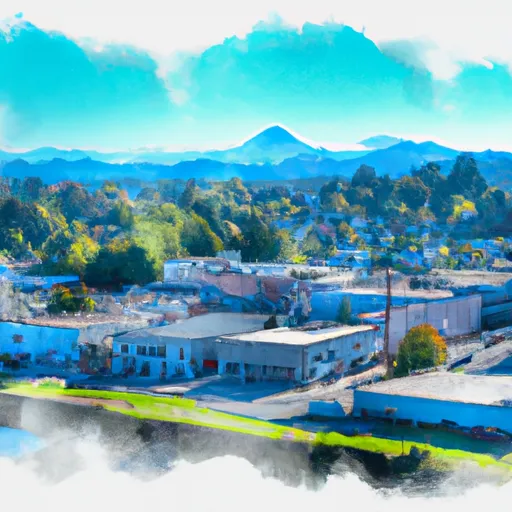-
 Snoflo Premium
Snoflo Premium
Get unlimited access to all our content
With no Ad interruptions! - Start Your Free Trial Login with existing account
Toutle
Eden Index
Climate
7.1
•
Recreation
3.7
•
Community
•
Safeguard
4.1/10

Toutle is a small town located in Cowlitz County, Washington. It is situated near the confluence of the North Toutle and South Toutle Rivers, which are both tributaries of the Cowlitz River. The climate in Toutle is characterized by mild, wet winters and warm, dry summers. The average annual rainfall is around 85 inches, with most of it received between October and April. The area experiences occasional snowfall during the winter months.
The hydrology constituents of Toutle are influenced by the nearby volcanic Mount St. Helens. The 1980 eruption of Mount St. Helens resulted in significant changes to the hydrological system, including the deposition of large amounts of sediment in the Toutle River system. This has led to ongoing efforts to manage and mitigate the effects of sedimentation in the area.
Despite the volcanic impact, Toutle offers numerous outdoor recreational opportunities. The surrounding landscape provides opportunities for hiking, camping, fishing, and wildlife viewing. The Toutle River offers fishing for species such as salmon and steelhead. Visitors can also explore the Mount St. Helens National Volcanic Monument, which offers a wealth of educational and recreational activities, including guided tours, interpretive centers, and scenic viewpoints.
What is the Eden Index?
The Snoflo Eden Index serves as a comprehensive rating system for regions, evaluating their desirability through a holistic assessment of climate health, outdoor recreation opportunities, and natural disaster risk, acknowledging the profound impact of these factors on livability and well-being.
Climate Health Indicator (CHI): 7.1
Toutle receives approximately
1516mm of rain per year,
with humidity levels near 88%
and air temperatures averaging around
10°C.
Toutle has a plant hardyness factor of
8, meaning
plants and agriculture in this region tend to thrive here all year round.
By considering the ideal temperature range, reliable water supplies, clean air, and stable seasonal rain or snowpacks, the Climate Health Indicator (CHI) underscores the significance of a healthy climate as the foundation for quality living.
A healthy climate is paramount for ensuring a high quality of life and livability in a region, fostering both physical well-being and environmental harmony. This can be characterized by ideal temperatures, reliable access to water supplies, clean air, and consistent seasonal rain or snowpacks.
Weather Forecast
Streamflow Conditions
Lower Columbia
Area Rivers
Lower Columbia
Snowpack Depths
Lower Columbia
Reservoir Storage Capacity
Lower Columbia
Groundwater Levels
Recreational Opportunity Index (ROI): 3.7
The Recreational Opportunity Index (ROI) recognizes the value of outdoor recreational options, such as parks, hiking trails, camping sites, and fishing spots, while acknowledging that climate plays a pivotal role in ensuring the comfort and consistency of these experiences.
Access to outdoor recreational opportunities, encompassing activities such as parks, hiking, camping, and fishing, is crucial for overall well-being, and the climate plays a pivotal role in enabling and enhancing these experiences, ensuring that individuals can engage in nature-based activities comfortably and consistently.
Camping Areas
| Campground | Campsites | Reservations | Toilets | Showers | Elevation |
|---|---|---|---|---|---|
| Seaquest State Park | 88 | 507 ft | |||
| Mayfield Lake - Tacoma Power | 55 | 444 ft | |||
| Louis Rasmussen RV Park | None | 32 ft | |||
| Ike Kinswa State Park | 103 | 445 ft |
Catastrophe Safeguard Index (CSI):
The Catastrophe Safeguard Index (CSI) recognizes that natural disaster risk, encompassing floods, fires, hurricanes, and tornadoes, can drastically affect safety and the overall appeal of an area.
The level of natural disaster risk in a region significantly affects safety and the overall livability, with climate change amplifying these risks by potentially increasing the frequency and intensity of events like floods, fires, hurricanes, and tornadoes, thereby posing substantial challenges to community resilience and well-being.
Community Resilience Indicator (CRI):
The Community Resilience Indicator (CRI) recognizes that education, healthcare, and socioeconomics are crucial to the well-being of a region. The CRI acknowledges the profound impact of these elements on residents' overall quality of life. By evaluating educational resources, healthcare accessibility, and economic inclusivity, the index captures the essential aspects that contribute to a thriving community, fostering resident satisfaction, equity, and social cohesion.

